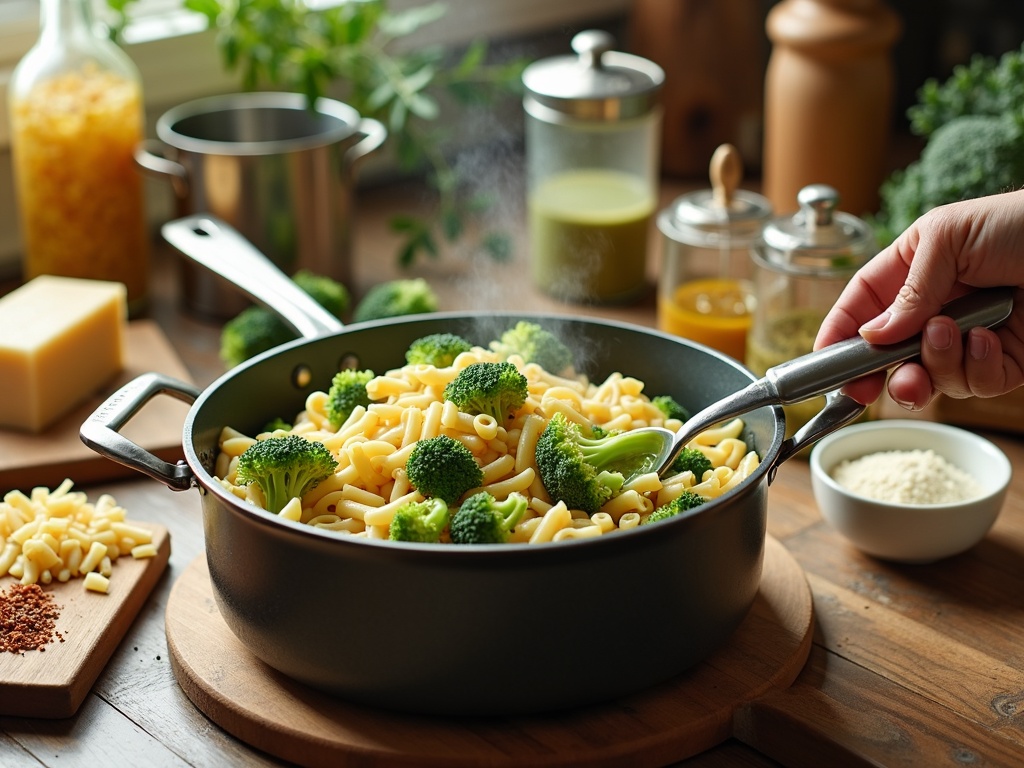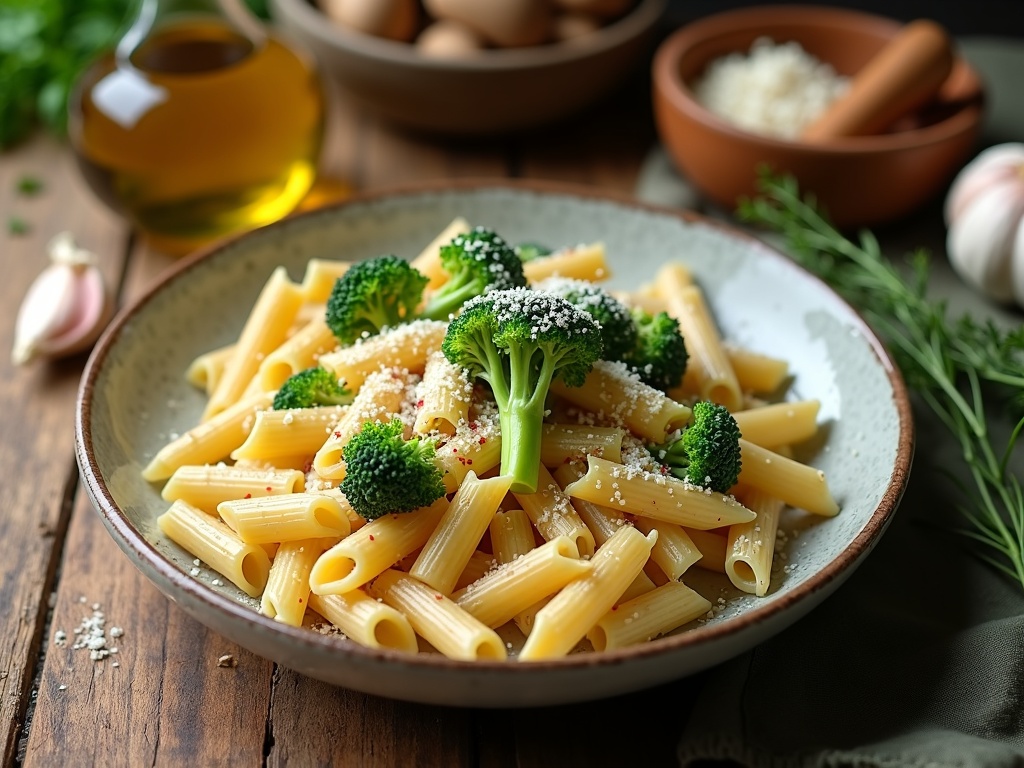Broccoli pasta combines simplicity, nutrition, and flavor, pairing al dente pasta with bright broccoli florets for a satisfying weeknight meal. I’ve found this adaptable dish works with many sauce variations from creamy options to light olive oil bases, making it a dependable dinner option that delivers both taste and practical benefits.
Find In This Article
Key Takeaways
- Ready in under 30 minutes, broccoli pasta requires just a few pantry staples and minimal cleanup, making it ideal for busy weeknights.
- The dish offers textural contrast when prepared correctly, with tender pasta complementing crisp-tender broccoli for an enjoyable eating experience.
- Reserving pasta water is essential for creating silky sauces that properly coat the pasta and broccoli.
- Uniform cutting of broccoli ensures even cooking, while avoiding overcooking maintains its vibrant color and nutritional value.
- The recipe can be easily customized with protein additions, different cheeses, or flavor boosters like sun-dried tomatoes and chili flakes.
What Makes This Dish Special
Broccoli pasta has become my go-to weeknight dinner for plenty of good reasons. The combination of al dente pasta with vibrant green broccoli creates a meal that’s both satisfying and nutritious. I’ve found that this simple dish punches well above its weight in terms of flavor, convenience, and health benefits.
A Perfect Balance of Flavors and Textures
The magic of broccoli pasta lies in its harmonious blend of textures and tastes. Tender pasta provides the perfect backdrop for slightly crisp broccoli florets. When these elements come together with a silky sauce, the result is truly something special.
The versatility of this dish also stands out. Some nights I crave a rich and creamy version with a velvety white sauce coating each piece of pasta and broccoli. Other evenings, I might opt for a lighter approach with a garlicky olive oil base or a vibrant homemade pesto that brings everything together.
The broccoli itself adds a mild, earthy flavor that pairs beautifully with pasta. When cooked correctly—just until tender-crisp—it maintains its bright green color and nutritional value. For those who enjoy more protein, adding some beef alongside the broccoli creates an even more substantial meal.
Practical Benefits Beyond Taste
This dish offers practical advantages that make it a staple in my kitchen:
- Ready in under 30 minutes: From pot to plate in less than half an hour, perfect for busy weeknights.
- One-pot wonder: Minimal cleanup when you cook the pasta and broccoli in the same pot.
- Budget-friendly ingredients: Basic pantry staples plus fresh broccoli won’t break the bank.
- Year-round availability: Broccoli is accessible in most grocery stores throughout the seasons.
- Freezer-friendly: Make extra and freeze portions for quick future meals.
The time-saving aspect can’t be overstated. I can have this dish ready faster than delivery would arrive, and it’s significantly healthier than takeout options. The efficiency comes from the simple cooking method—I often steam the broccoli right on top of the boiling pasta during the final few minutes of cooking.
The affordability factor makes broccoli pasta a smart choice for feeding families or stretching your grocery budget. While it sits comfortably among beloved Italian dishes, it requires none of the expensive ingredients that some Italian classics demand.
Broccoli pasta also serves as a clever way to incorporate more vegetables into your diet. The broccoli isn’t just an afterthought—it’s a star ingredient that provides fiber, vitamins, and minerals. For picky eaters or children, this dish offers a tasty gateway to vegetable consumption.
The recipe’s adaptability means it works beautifully as a main course or as one of several pasta side dishes for a larger gathering. I can dress it up with premium ingredients for guests or keep it simple for everyday meals.
Whether you’re cooking for yourself, your family, or friends, broccoli pasta delivers on all fronts—nutrition, flavor, convenience, and cost. Its special qualities emerge from this perfect balance of practical benefits and culinary satisfaction, making it much more than just another pasta dish.
Everything You’ll Need
Getting your ingredients ready before cooking makes Italian dishes like broccoli pasta much easier to prepare. I’ve found that having everything measured and chopped beforehand creates a smoother cooking experience.
Essential Ingredients
Short pasta works best for this dish because it catches all the creamy sauce in its nooks and crannies. I prefer penne, fusilli, or rigatoni since they hold up well against the heartiness of broccoli. For a complete meal, you might consider serving it with other pasta side dishes for variety.
Fresh broccoli florets add both nutrition and texture. Cut them into bite-sized pieces so they cook evenly and blend well with the pasta. If you enjoy meaty versions, you can adapt techniques from beef broccoli recipes to incorporate protein.
Heavy cream creates that luxurious base that makes this dish so satisfying. You’ll need about half a cup for a pound of pasta, but you can adjust based on how creamy you like your sauce. For a lighter alternative, consider trying my white sauce pasta recipe which offers similar creaminess.
Parmesan cheese adds the perfect savory element. Freshly grated works best, as pre-packaged versions don’t melt as smoothly.
Garlic cloves provide essential flavor depth. I typically use 2-3 cloves, finely minced.
Olive oil is needed for sautéing your garlic and broccoli. A good quality extra virgin olive oil makes a noticeable difference.
Salt and pepper are basic but crucial for proper seasoning. I always taste as I go to get the balance just right.
Red pepper flakes add a pleasant heat if you enjoy a bit of spice. They’re completely optional but can elevate the dish. For an alternative flavor profile, you might explore pesto recipe variations that incorporate broccoli instead of basil.
Having these simple ingredients on hand means you’re always ready to create a comforting, satisfying meal that comes together in less than 30 minutes. The beauty of broccoli pasta lies in its simplicity and flexibility.
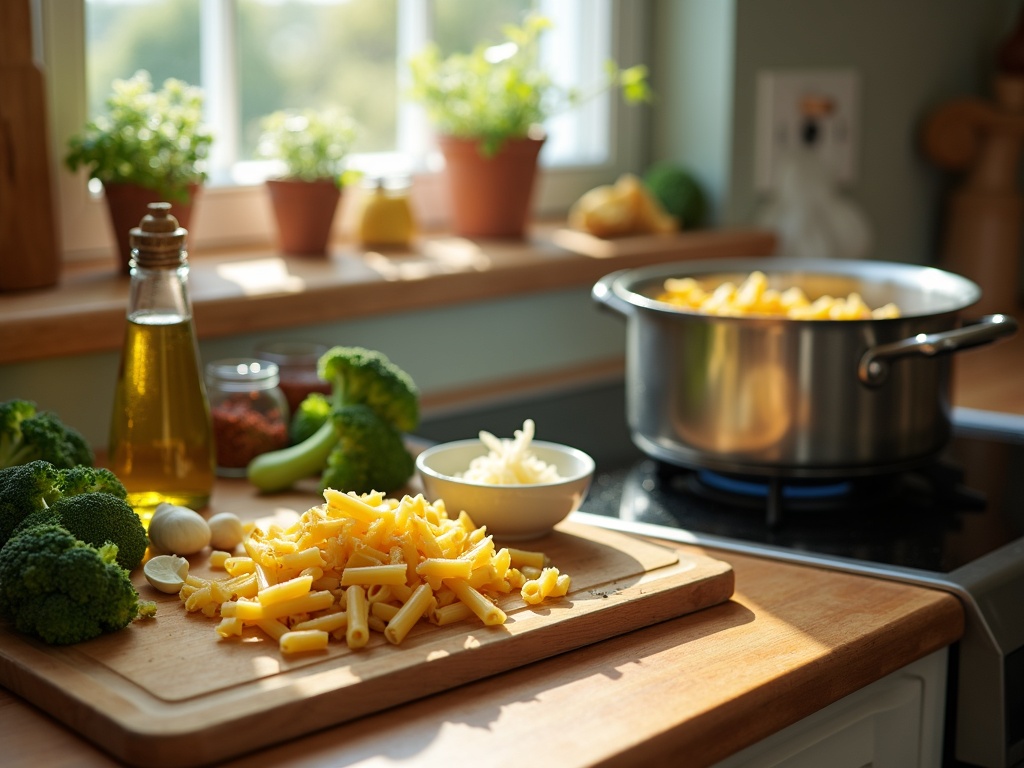
Step-By-Step Cooking Instructions
Creating a delicious broccoli pasta dish is simpler than you might think. I’ve broken down the process into manageable steps that’ll have you serving up this nutritious meal in no time.
Preparing the Components
First, I’ll start by boiling the pasta. Fill a large pot with water, add a generous pinch of salt, and bring it to a rolling boil. Add your favorite pasta – penne, fusilli, or farfalle work wonderfully with broccoli. Cook according to the package directions until it reaches the perfect al dente texture. For an authentic Italian touch, try cooking it about a minute less than the package suggests for that ideal bite. If you’re looking for more authentic Italian inspiration, check out these traditional Italian pasta dishes that complement broccoli beautifully.
While the pasta cooks, I prepare the broccoli. Cut the florets into bite-sized pieces for easy eating. Steam them either in a steamer basket over boiling water or in a microwave-safe container with a splash of water covered with a plate. They’ll need just 3-4 minutes until they turn bright green and become tender-crisp. Be careful not to overcook them – soggy broccoli ruins the texture contrast in the final dish.
For the aromatic base, heat 2-3 tablespoons of olive oil in a large skillet over medium heat. Add 2-3 minced garlic cloves and sauté for about 30 seconds until fragrant but not browned. Burnt garlic becomes bitter, so I keep a close eye on it.
Now for the sauce – there are several delicious options:
- Cream-based: Reduce heat to low and add 1 cup of heavy cream to the garlic oil. Let it simmer gently for 2-3 minutes, then stir in ½ cup of grated Parmesan cheese until melted and smooth. For a richer variation, try making a white sauce pasta base.
- Olive oil-based: Skip the cream and use the garlic-infused oil as your sauce, adding red pepper flakes for heat if desired.
- Pesto option: Stir in 3-4 tablespoons of homemade pesto to the garlic oil for a vibrant green sauce.
Once the pasta is cooked, drain it well but reserve about ½ cup of the starchy cooking water. Add the pasta directly to your sauce in the skillet along with the steamed broccoli. Toss everything together gently using tongs or two spoons. If the sauce seems too thick, add a splash of the reserved pasta water – it contains starch that helps the sauce cling to the pasta.
Season with salt and freshly ground black pepper to taste. For an extra dimension of flavor, I sometimes add a squeeze of fresh lemon juice or lemon zest at this stage.
For protein lovers, this dish pairs wonderfully with grilled chicken, or you could try adapting elements from this beef and broccoli recipe for a fusion twist.
Serve your broccoli pasta immediately in warmed bowls, with extra grated cheese on the side. This versatile recipe can be the star of your dinner or function as one of several pasta side dishes for a larger meal.
The beauty of this dish lies in its adaptability – once you’ve mastered the basic technique, you can customize it with different herbs, spice levels, and add-ins to suit your taste preferences or use whatever ingredients you have on hand.

Common Mistakes to Watch Out For
When making broccoli pasta, small errors can make a big difference between a mediocre meal and a restaurant-quality dish. I’ve made plenty of mistakes myself over the years and have learned what pitfalls to avoid.
Key Errors That Can Ruin Your Broccoli Pasta
Overcooking the broccoli is perhaps the most common mistake. I’ve found that perfectly cooked broccoli should maintain a vibrant green color and slight crunch. When broccoli is overcooked, it turns mushy, loses its nutritional value, and develops that unpleasant sulfurous smell. To avoid this, I blanch my broccoli for just 2-3 minutes before adding it to pasta, or add it directly to the pasta water during the last 3 minutes of cooking. If you’re looking for more complex flavors, try complementing your broccoli pasta with creamy white sauce for a luxurious twist.
Using too little pasta water is a mistake that affects the entire dish. Pasta needs room to move and expand while cooking. Additionally, that starchy pasta water is liquid gold! I always reserve about a cup before draining. This starchy water helps bind the sauce to the pasta and creates the perfect consistency. For pasta dishes that require more protein, beef and broccoli makes an excellent pairing with pasta as well.
Adding cold cream to hot pasta can cause the sauce to break or curdle. I always let dairy ingredients come to room temperature before adding them to hot pasta. Alternatively, I temper the cold cream by slowly adding a bit of the hot pasta water to it before incorporating it into the dish. This creates a smoother, more integrated sauce. If you’re looking for a dairy-free option, homemade pesto makes an excellent sauce for broccoli pasta.
Not seasoning properly is a fundamental error that can leave your broccoli pasta tasting flat. I always salt my pasta water generously—it should taste like seawater. This initial seasoning is crucial as it’s absorbed into the pasta as it cooks. I also taste and adjust seasoning at multiple stages: when blanching the broccoli, when creating the sauce, and just before serving. For inspiration on what to serve alongside your broccoli pasta, check out these complementary pasta side dishes.
Here are some additional mistakes to watch out for:
- Using the wrong pasta shape: Long pasta like spaghetti works well with broccoli florets, while pasta shapes with ridges or hollows (like penne or orecchiette) trap the smaller bits of broccoli and sauce better.
- Not cooking pasta al dente: Slightly firm pasta provides the perfect textural contrast to the tender broccoli.
- Rinsing pasta after cooking: This removes the starch that helps sauce adhere.
- Using low-quality olive oil: The flavor of olive oil is prominent in many broccoli pasta recipes, so using a good one makes a difference.
Broccoli pasta is a staple in traditional Italian cuisine, and learning to avoid these common pitfalls will help you create authentic, delicious results every time. I’ve found that paying attention to these details transforms a simple broccoli pasta from an everyday meal into something truly special that family and friends will request again and again.
Pro Tips for the Perfect Dish
Making broccoli pasta is simple, but taking it from good to exceptional requires attention to a few key details. I’ve gathered some professional techniques that will elevate your next broccoli pasta dish to restaurant quality without any complicated steps.
Essential Techniques for Success
Always reserve about 1 cup of pasta water before draining your noodles. This starchy liquid is like liquid gold in cooking – it helps bind the sauce to the pasta and creates a silky texture that can’t be replicated with plain water. If your finished dish seems dry, add a splash of this reserved water to bring everything together beautifully.
Uniform broccoli pieces aren’t just about presentation – they ensure even cooking. I cut my florets to similar sizes (about 1-1.5 inches) so everything cooks at the same rate. For stems, I peel the tough outer layer and slice them into bite-sized pieces that match the florets. This prevents having some pieces undercooked while others turn mushy.
Garlic provides essential flavor to Italian dishes, but it requires careful handling. I toast garlic in olive oil until it becomes fragrant but watch it closely to prevent browning. Burnt garlic turns bitter and can ruin your entire dish. The perfect garlic should be golden and aromatic – this typically takes about 30-60 seconds in hot oil.
Don’t underestimate the importance of freshly grated cheese. Pre-packaged grated cheese contains anti-caking agents that affect melting quality. I always take the extra minute to grate Parmesan, pecorino, or other hard cheeses right before adding them to my white sauce pasta. The difference in flavor and texture is remarkable.
Pasta shape matters more than you might think. For chunky broccoli florets, shapes like penne, rigatoni, or farfalle work best as they catch small pieces in their nooks. For a dish with finely chopped broccoli, spaghetti or linguine creates a more elegant presentation.
Consider blanching your broccoli separately rather than cooking it with the pasta. This gives you perfect control over its texture – I aim for tender-crisp so it maintains its vibrant green color and nutritional value. After blanching, I shock it in ice water to stop the cooking process before adding it to the final dish.
For an extra flavor boost, try roasting your broccoli instead of boiling it. Toss florets with olive oil, salt and pepper, then roast at 425°F for about 15-20 minutes until edges are crispy. This creates a delicious caramelized flavor that pairs wonderfully with pesto or cream-based sauces.
Balance is key in a great broccoli pasta. I add acid through a squeeze of lemon juice or a splash of white wine to cut through richness, especially in creamy versions. A pinch of red pepper flakes adds welcome heat without overpowering the dish.
Don’t forget about texture – toasted pine nuts, breadcrumbs, or even crispy prosciutto bits can add delightful crunch to contrast the tender pasta and broccoli. These finishing touches transform a simple weeknight dinner into something special that could feature among your favorite pasta side dishes.
Lastly, season throughout the cooking process rather than just at the end. I salt my pasta water generously (it should taste like seawater), season the broccoli as it cooks, and adjust final seasoning before serving. This layering of salt creates depth of flavor that can’t be achieved with last-minute seasoning alone.
Make It Your Own
Broccoli pasta serves as a versatile canvas that can be customized to suit any palate. I’ve found that with a few simple additions, this dish transforms from a basic weeknight meal into something truly special that the whole family will enjoy.
Protein Additions
Adding protein to broccoli pasta elevates it from a side dish to a complete meal. Grilled chicken is my go-to protein choice, as its mild flavor complements the earthiness of broccoli without overpowering it. I simply season chicken breasts with salt, pepper, and Italian herbs before grilling and slicing them to top my pasta.
For a more substantial meal option, consider these protein additions:
- Grilled chicken breast, sliced into strips
- Sautéed shrimp for a seafood twist
- Pan-seared tofu cubes for a vegetarian alternative
- Ground beef cooked with Italian seasonings, similar to my beef and broccoli recipe but adapted for pasta
Flavor Boosters
The right additions can transform a simple broccoli pasta into a gourmet experience. Sun-dried tomatoes add a concentrated burst of sweet-tart flavor that pairs beautifully with the broccoli’s earthiness. I like to chop them finely and stir them in during the last few minutes of cooking.
Cheese variations offer another easy way to customize this dish. While Parmesan is traditional, I often experiment with:
- Crumbled feta for a Mediterranean flair
- Smoked gouda for depth
- Creamy goat cheese dollops that melt into the pasta
- Mozzarella pearls for stretchy, gooey texture
For those who enjoy heat, a sprinkle of chili flakes brings a pleasant warmth that cuts through the richness of white sauce pasta variations. I’ll sometimes substitute with Aleppo pepper or Korean gochugaru for a more complex spice profile.
Don’t be afraid to experiment with different sauces either. While a classic olive oil and garlic base works wonderfully, I sometimes switch to a homemade pesto for a herbaceous twist. This flexibility makes broccoli pasta a perfect addition to your repertoire of pasta side dishes or even as the star of your Italian dishes collection.
The beauty of broccoli pasta lies in its adaptability—I can make it creamy and indulgent one night, light and zesty the next. Each variation brings new life to this simple yet satisfying dish, proving that sometimes the most basic ingredients create the most beloved family favorites.
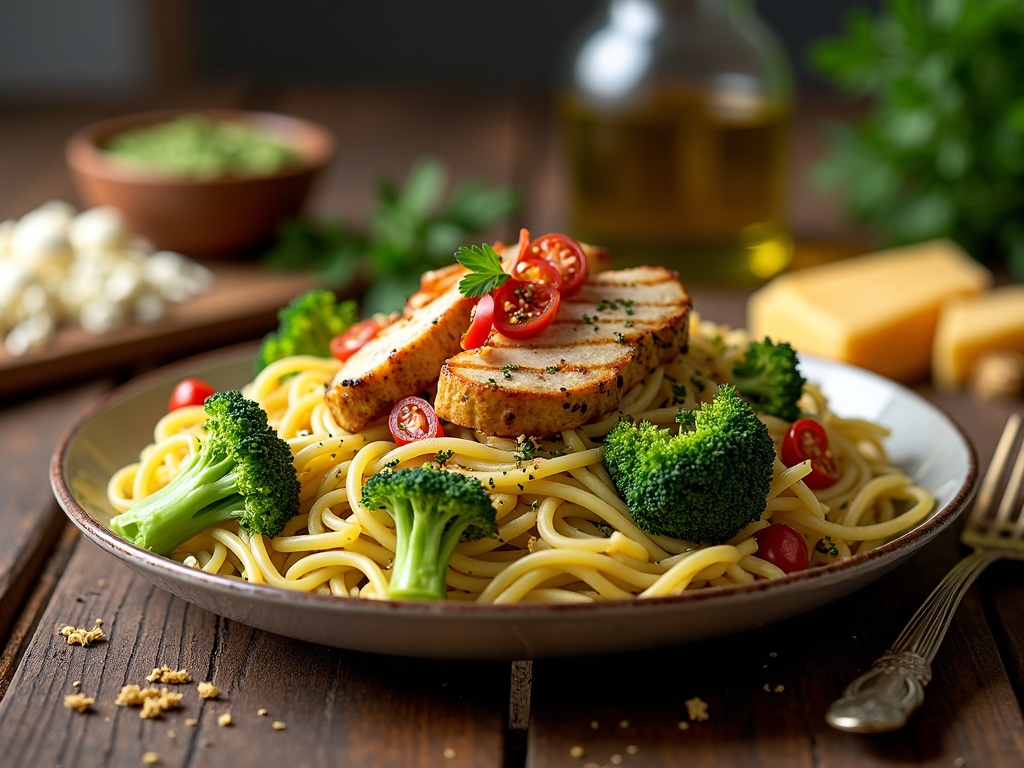
Storage and Reheating
Properly storing broccoli pasta can help maintain its flavors and textures for several days. I’ve found that following a few simple guidelines makes all the difference in enjoying leftovers that taste almost as good as when freshly made.
Proper Storage Techniques
After your delicious broccoli pasta has cooled to room temperature, transfer it to an airtight container. Glass containers with secure lids work exceptionally well as they don’t absorb food odors or stains. Plastic containers are fine too, but make sure they seal completely to prevent air from getting in.
When stored correctly in the refrigerator, your pasta dish stays fresh for 3-4 days. I recommend labeling containers with the date you stored them to keep track of freshness. If you notice any off smells or appearance changes before the 3-4 day mark, it’s better to discard the leftovers.
For longer preservation, you can freeze your broccoli pasta, though the texture of both the pasta and broccoli will change somewhat upon thawing. If freezing, portion the pasta into meal-sized servings so you only need to thaw what you’ll eat.
Reheating for Optimal Flavor
Reheating pasta dishes can be tricky since they tend to dry out, but adding a splash of milk when reheating cream-based pasta sauces helps restore their creamy consistency. For oil-based pastas like those with pesto, a small drizzle of olive oil works better than milk.
The microwave offers the quickest reheating method:
- Place your portion in a microwave-safe dish
- Add a splash of milk or drizzle of olive oil depending on your sauce type
- Cover loosely to prevent splatters
- Heat on medium power for 1-2 minutes
- Stir thoroughly
- Continue heating in 30-second intervals until heated through
For superior results, reheat your pasta on the stovetop:
- Add your pasta to a non-stick pan
- Include a splash of milk or oil as needed
- Heat on medium-low
- Stir frequently while warming up to distribute heat evenly
- The stirring prevents the pasta from sticking and helps revitalize the sauce
I’ve discovered that stirring is particularly important when reheating any Italian dishes with creamy sauces, as it prevents the oils from separating and helps maintain that silky texture that makes these dishes so enjoyable.
For best flavor preservation, avoid reheating the entire batch if you won’t eat it all. Instead, warm only what you plan to consume. This practice keeps the remaining portion fresher for longer.
If your broccoli pasta seems a bit bland after storage, a sprinkle of freshly grated cheese or a few red pepper flakes can quickly bring it back to life, making it an excellent option among quick pasta side dishes for your next meal.
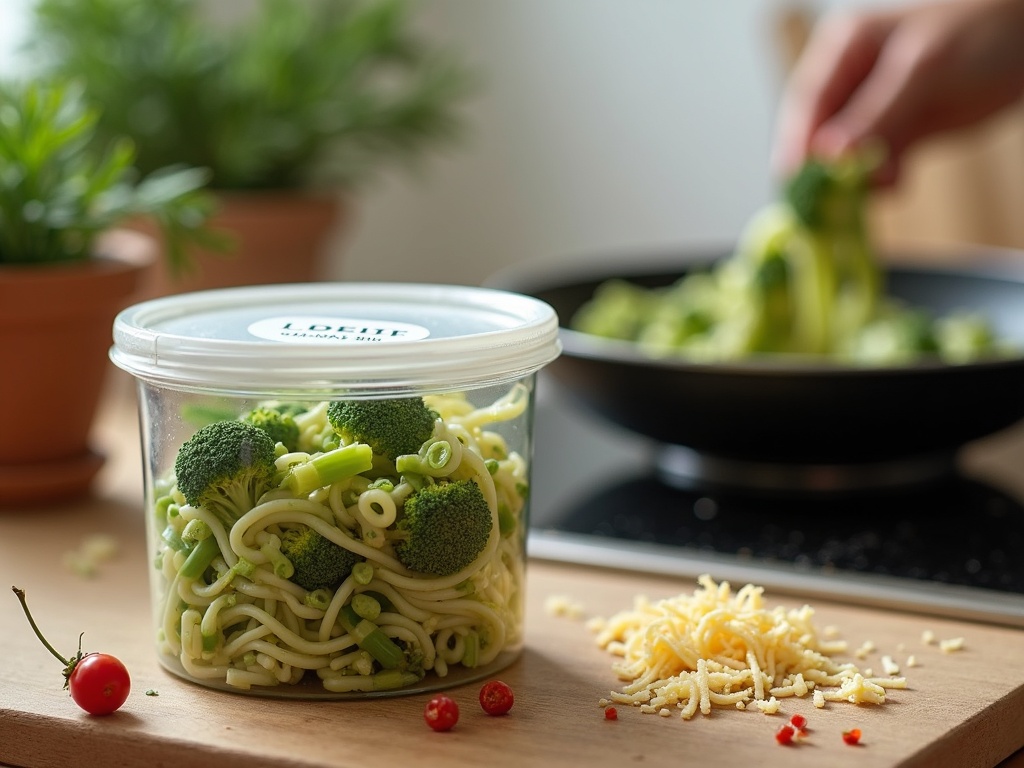
Why This Recipe Works for Busy Weeknights
After a long day, the last thing I want is to spend hours in the kitchen. That’s why I’ve fallen in love with this broccoli pasta recipe—it’s become my weeknight dinner hero. This dish strikes the perfect balance between nutrition and convenience, making it ideal for those evenings when time is tight but I still want something satisfying.
Quick Prep with Pantry Staples
The beauty of this broccoli pasta lies in its simplicity. I can have dinner on the table in under 30 minutes, which is a lifesaver on hectic evenings. The recipe uses ingredients I already keep stocked:
- Dried pasta (any shape works, though penne or fusilli hold the sauce nicely)
- Fresh or frozen broccoli (no fancy ingredients needed)
- Garlic and olive oil (kitchen essentials)
- Parmesan cheese (the pre-grated kind works in a pinch)
- Salt, pepper, and red pepper flakes
I love that I can make this dish without a special trip to the grocery store. For those times when I want to add a creamy element, I can transform it into a white sauce pasta with just a few additional ingredients.
The prep work is minimal—just chop the broccoli, mince some garlic, and measure a few ingredients. I can even use frozen broccoli florets to eliminate the chopping step entirely. While this dish is vegetarian, I sometimes add protein like chicken or chickpeas, similar to how I’d approach a beef broccoli stir-fry, adapting the core technique to what I have available.
One-Pot Wonder
The one-pot approach is a game-changer for busy weeknights. I simply:
- Cook the pasta until almost al dente
- Add the broccoli to the same pot during the final minutes of cooking
- Drain and return to the pot
- Stir in olive oil, garlic, cheese, and seasonings
This method means fewer dishes to wash afterward—just one pot, a cutting board, and a few measuring tools. The cleanup is almost as quick as the cooking process itself.
For flavor variations, I sometimes stir in a dollop of pesto at the end, which adds incredible depth without extra work. The versatility makes this dish a reliable foundation for countless meals.
The efficiency of this recipe doesn’t just save time—it saves mental energy. On nights when decision fatigue has set in, having this trusted formula means I don’t need to think too hard about what to make.
The recipe yields generous portions, making it perfect for families or for creating leftovers. I often make a double batch so I have lunch sorted for the next day. The pasta reheats beautifully, making it even more practical for busy schedules.
This broccoli pasta has become a staple in my rotation of pasta side dishes, though it’s hearty enough to serve as a main course. The combination of starchy pasta and nutritious broccoli creates a satisfying meal that doesn’t leave me hungry an hour later.
What makes this recipe truly special is how it delivers comfort food vibes without complexity. There’s something universally appealing about pasta dishes—they’re the definition of crowd-pleasers. Even picky eaters tend to enjoy this meal, especially when I let them customize their portion with extra cheese or their favorite seasonings.
For those interested in expanding their pasta repertoire, this recipe serves as an excellent gateway to exploring more Italian dishes while maintaining the convenience factor that makes weeknight cooking manageable.
